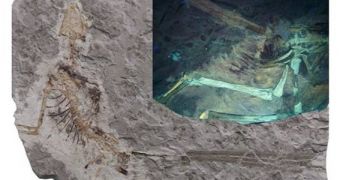An international team of paleontologists and investigators, including researchers from the Queen Mary University of London (QUML), in the United Kingdom, has recently discovered a new wealth of fossils in a deposit located in Inner Mongolia, China. The findings highlight an unexpected level of ecological diversity on Earth more than 160 million years ago.
Most of the fossils found at the Daohugou site – collectively known as the Daohugou Biota – date back to around 30 million years before the Cretaceous-Paleogene (K-Pg) mass extinction event that wiped out the dinosaurs, around 65.5 million years ago. As such, they offer unprecedented view into a time called the Middle-Upper Jurassic Period.
What is even more interesting is that this is just one of several sites in the region that have yielded some impressively well-preserved fossils. Additionally, all of these sites have been linked together through the presence of a single species of now-extinct salamander, called Chunerpeton tianyiensis.
In a paper published in the latest issue of the esteemed Journal of Vertebrate Paleontology, researchers argue that this study is one of the first to focus on pre-Cretaceous Period fossils at sites in northeastern and central China, including the famous western Liaoning Province. Thus far, paleontologists have discovered early birds, mammals, and dinosaurs throughout these sites.
However, most of these specimens are from the Cretaceous Period, from 145 to 65 million years ago. In recent years, investigations such as those being conducted at the Daohugou site have started painting a picture of just how ecologically-diverse lifeforms were during the Jurassic, the age between 201 and 145 million years ago.
In their new paper, investigators argue that a very large number of vertebrate groups, including mammals, were undergoing evolutionary diversification at the time they were trapped in the Daohugou site, around 160 million years ago.
As such, continued investigations at such locations could provide scientists with a new understanding of how vertebrate evolution occurred during the Middle-Upper Jurassic Period, an age that has remained somewhat mysterious for paleontologists.
Some of the most notable specimens in the Daohugou Biota include the oldest-known gliding mammal, the earliest mammal to have swam using a beaver-like tail, the oldest feathered dinosaur, and a missing link pterosaur connecting two major groups of flying lizards. It is very likely that additional findings will be made to bridge gaps in our knowledge of how numerous species evolved during that time.
“The diversity seen here is impressive and important,” explains study coauthor Dr. David Hone, who holds an appointment with the School of Biological and Chemical Sciences at QMUL.
“The Daohugou has, so far, been rather less studied than the more famous Jehol group of China, and yet is already producing high numbers of superbly preserved specimens from a range of not only new species, but lineages of animals that are currently unknown elsewhere in the fossil record,” he adds.
The new investigation even revealed a salamander specimen that still featured its external gills, something that is extremely rare in paleontology. Generally speaking, exterior traits are lost during the natural decay process, before fossils can be set in stone. Some skeletons at the Mongolian site even feature soft tissues, including skin, fur, and feathers, which should help scientists with their studies.
“One of the most important things the Daohugou Biota reveals is that Mesozoic mammals were a lot more ecologically diverse than most palaeontologists would have guessed even a decade ago,” adds Dr. Corwin Sullivan, the lead author of the new study.
“To recover a gliding species and a swimming species from the Jurassic was unexpected, to say the least,” adds the expert, who holds an appointment with the Institute of Vertebrate Paleontology and Paleoanthropology (IVPP) at the Chinese Academy of Sciences, in Beijing.

 14 DAY TRIAL //
14 DAY TRIAL //